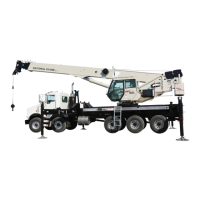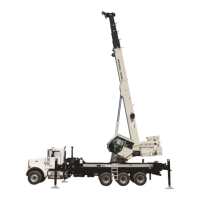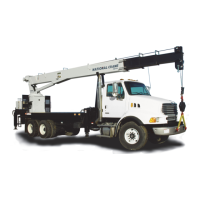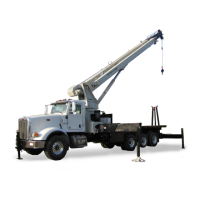NATIONAL CRANE Published 11-01-2020 Control # 710-00 2-33
NBT60XL OPERATOR MANUAL SAFETY PRECAUTIONS
Make sure that the rope is properly routed on the hook block
and boom nose and that all rope guards are in place.
Lifting
Use enough parts of line for all lifts and check all lines,
slings, and chains for correct attachment. To obtain
maximum lifting capacities, the hook block must be set up
with enough parts of line. Too few parts of line can result in
failure of the hoist rope or hoist. No less than three wraps of
rope should remain on the hoist drum. When slings, ties,
hooks, etc., are used, make sure that they are correctly
positioned and secured before raising or lowering the loads.
Make sure that the rigging is adequate before lifting. Use tag
lines when possible to position and restrain loads. Personnel
using tag lines should be on the ground.
Make sure that good rigging practices are being used.
Refuse to use any poorly maintained or damaged
equipment. Never wrap the hoist cable around a load.
If using a clam bucket, do not exceed 80% of the equipment
capacity.
Make certain the boom tip is centered directly over the load
before lifting.
Ensure that all slings, ties, and hooks are correctly placed
and secured before raising or lowering the load.
Make sure that the load is well secured and attached to the
hook with rigging of proper size and in good condition.
Check the hoist brake by raising the load a few inches,
stopping the hoist and holding the load. Make sure that the
hoist brake is working correctly before continuing the lift.
When lowering a load always slow down the load’s descent
before stopping the hoist. Do not attempt to change speeds
on multiple-speed hoists while the hoist is in motion.
Watch the path of the boom and load when swinging. Avoid
lowering or swinging the boom and load into ground
personnel, equipment, or other objects.
Lift one load at a time. Do not lift two or more separately
rigged loads at one time, even if the loads are within the
equipment rated capacity.
Never leave the equipment with a load suspended. Should it
become necessary to leave the equipment, lower the load to
the ground and stop the engine before leaving the operator’s
station.
Remember, all rigging equipment must be considered as
part of the load. Lifting capacities vary with working areas. If
applicable, permissible working areas are listed in the Load
Chart. When swinging from one working area to another,
make sure that Load Chart capacities are not exceeded.
Know your equipment!
Stop the hook block from swinging when unhooking a load.
Swinging rapidly can cause the load to swing out and
increase the load radius. Swing the load slowly. Swing with
caution and keep the load lines vertical.
Look before swinging your equipment. Even though the
original setup may have been checked, situations do
change.
Never swing or lower the boom into the carrier cab (if
applicable).
Never push or pull loads with the equipment boom; never
drag a load.
Do not subject the equipment to side loading. A side load can
tip the equipment or cause it to fail structurally.
If the boom should contact an object, stop immediately and
inspect the boom. Remove the equipment from service if the
boom is damaged.
When lifting a load the boom may deflect causing the load
radius to increase—this condition is made worse when the
boom is extended. Make sure that the weight of load is within
equipment’s capacity on Load Chart.
Avoid sudden starts and stops when moving the load. The
inertia and an increased load radius could tip the equipment
over or cause it to fail structurally.
Fo
r
Reference
Only
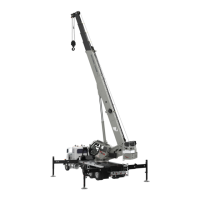
